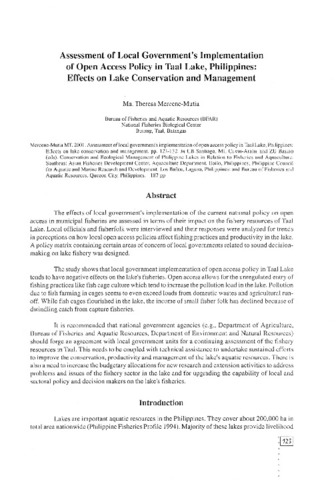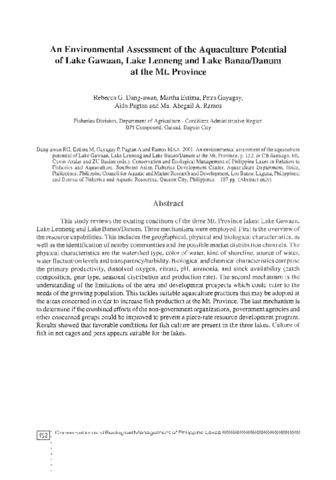Assessment of local government's implementation of open access policy in Taal Lake, Philippines: Effects on lake conservation and management
Share
abstrak
The effects of local government's implementation of the current national policy on open access in municipal fisheries are assessed in terms of their impact on the fishery resources of Taal Lake. Local officials and fisherfolk were interviewed and their responses were analyzed for trends in perceptions on how local open access policies affect fishing practices and productivity in the lake. A policy matrix containing certain areas of concern of local governments related to sound decisionmaking on lake fishery was designed.
The study shows that local government implementation of open access policy in Taal Lake tends to have negative effects on the lake's fisheries. Open access allows for the unregulated entry of fishing practices like fish cage culture which tend to increase the pollution load in the lake. Pollution due to fish farming in cages seems to even exceed loads from domestic wastes and agricultural runoff. While fish cages flourished in the lake, the income of small fisher folk has declined because of dwindling catch from capture fisheries.
It is recommended that national government agencies (e.g., Department of Agriculture, Bureau of Fisheries and Aquatic Resources, Department of Environment and Natural Resources) should forge an agreement with local government units for a continuing assessment of the fishery resources in Taal. This needs to be coupled with technical assistance to undertake sustained efforts to improve the conservation, productivity and management of the lake's aquatic resources. There is also a need to increase the budgetary allocations for new research and extension activities to address problems and issues of the fishery sector in the lake and for upgrading the capability of local and sectoral policy and decision makers on the lake's fisheries.
Suggested Citation
Mercene-Mutia, M. T. (2001). Assessment of local government's implementation of open access policy in Taal Lake, Philippines: Effects on lake conservation and management. In C. B. Santiago, M. L. Cuvin-Aralar, & Z. U. Basiao (Eds.), Conservation and Ecological Management of Philippine Lakes in Relation to Fisheries and Aquaculture (pp. 123-132). Tigbauan, Iloilo, Philippines: Aquaculture Department, Southeast Asian Fisheries Development Center; Los Baños, Laguna, Philippines: Philippine Council for Aquatic and Marine Research and Development (PCAMRD), Department of Science and Technology; Quezon City, Philippines: Bureau of Fisheries and Aquatic Resources (BFAR), Department of Agriculture, Quezon City, Philippines.
Subjek
Related items
Showing items related by title, author, creator and subject.
-
An environmental assessment of the aquaculture potential of Lake Gawaan, Lake Lenneng and Lake Banao/Danum at the Mt. Province
Dang-awan, Rebecca G.; Estima, Martha; Gayagay, Petra; Pagtan, Aida; Ramos, Ma. Abegail A. (Aquaculture Department, Southeast Asian Fisheries Development Center; Philippine Council for Aquatic and Marine Research and Development (PCAMRD), Department of Science and Technology; Bureau of Fisheries and Aquatic Resources, 2001)This study reviews the existing conditions of the three Mt. Province lakes: Lake Gawaan, Lake Lenneng and Lake Banao/Danum. Three mechanisms were employed. First is the overview of the resource capabilities. This includes ... -
Revitalizing Boeung Tonle Chhmar in Tonle Sap Lake, Cambodia through ecosystem approach to fisheries management and co-management
Tiaye, Rattana; Lieng, Sopha (Secretariat, Southeast Asian Fisheries Development Center, 2024-10)SEAFDEC/TD has long promoted the concepts of ecosystem approach to fisheries management (EAFM) and co-management, particularly for coastal small-scale fisheries, across the SEAFDEC Member Countries. These approaches aim ... -
Restoration and Enhancement of Fisheries in Philippine Lakes and Reservoirs
Palma, Adelaida L. (Training Department, Southeast Asian Fisheries Development Center, 2016)Inland water resources of the Philippines host some 348 freshwater fishes, of which 16% are endemic and 56% indigenous (FishBase 2013). Although production from inland capture fisheries accounts for only 7.8% of the total ...






